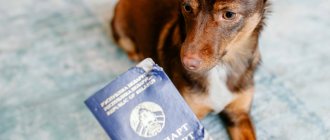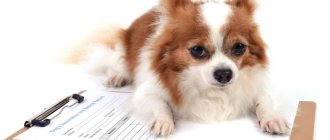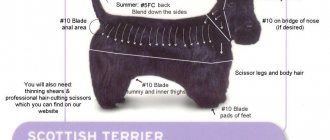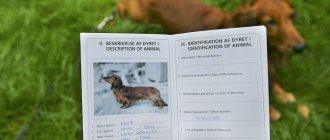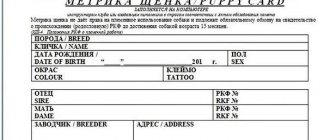The pedigree for a dog is represented by an official document, which is necessary to confirm the fact of thoroughbred. A special document displays all the necessary data about the dog - its origin and the origin of its closest ancestors - males and females up to the 4th generation.
An official document in the form of a pedigree for a dog allows you to confirm the fact that 3 generations of dogs participating in mating are registered in a special stud book and belong to the same breed.
A formalized pedigree for a dog allows you to avoid receiving special assessments at exhibitions confirming that it belongs to a particular breed. In addition to the puppy’s ancestors, the pedigree must indicate the details of the specific animal - the day of birth, year and month, whether it is male or female, as well as its nickname. In addition to the above data, the dog’s pedigree indicates a serial number corresponding to registration in a special stud book.
Having a number in a dog's pedigree is very important. Thanks to the puppy's number included in the official document, it is possible to trace the origin of the purebred animal without any problems, right down to the most distant ancestors, who are the initial ones in breeding the breed. There are special bases, access to which is provided through large clubs. They store all the information about dog breeds.
Is a purebred puppy a puppy with documents?
A puppy that is obtained from purebred parents in compliance with all rules and permits and at the same time fully complies with the standards of its breed without any defects is purebred. The pedigree of a dog as a document speaks about the origin of the dog - its family tree. But with the above, it is important to understand that pedigree does not in any way guarantee the puppy’s working qualities, training, suitability for certain types of service and performance of various tasks. The very concept of a “puppy with documents” speaks of the purity of its breeding line, of its belonging to the breed without any impurities.
Puppy metric
Following the example of human children, a puppy must have a special metric, which, when it reaches a certain age, will be replaced with a full-fledged, “adult” document with official genealogies. The card also indicates all the features of a particular representative of the breed. If fundamental deficiencies are identified, it is necessary to make a note that the individual does not represent breeding value.
The card contains basic information about the puppy:
- breed;
- nickname;
- date of birth;
- floor;
- suit;
- stamp number;
- information about father and mother;
- address and passport information of the puppy's owner.
This is what a brand on a dog looks like
Attention: in addition to the data, it is important to study stamps and signatures. The card must have a stamp and the full name of the institution where it was received, as well as the data (signature with transcript) of the official
The top and bottom of a document serve different purposes. What is above the cut line is then transferred to the Russian Cynological Federation. The bottom form remains with the owner
It is important not to lose a copy, because if the official pedigree is lost, it will only be possible to restore it using it. You will also need it when registering for the exhibition.
But only until the dog turns one year and three months old - from that moment on, the “puppy” is invalid. Until this moment, it must be exchanged for a full-fledged pedigree. No one bothers you to do it later if you failed to attend to the issue in time, but being late is fraught with a fine.
Certificate of origin of the dog
Filling rules
Like any other identification document, the metric must be filled out correctly. All words are written in full, in legible printed letters. It should be remembered that as an RKF employee understands this or that word, he will then write it in the pedigree.
Actually, very little is required from the owner:
- provide your passport information and address;
- remember the index of your place of residence.
The latter must fit in; without the index, they won’t take the “puppy.”
Is it possible to make documents without a puppy card?
Metrica is a guarantee of a smooth receipt of an adult document in the future. Without a card, you will only be able to obtain a registered pedigree. It confirms the fact of belonging to the breed, but you can forget about exhibitions and prizes.
Pedigree for a dog - what does it look like?
Pedigrees from March 1, 2022 are issued in 2 types:
- Certificate of origin of a single sample. (blue form with watermarks and QR code DOES NOT LAMINATE).
It is bilingual, in Russian and English. Its main difference and advantage is that it contains information about 3 generations of ancestors. This option is used for participation in Russian and foreign exhibitions and for breeding. It can also be marked “Export”, which turns the document into an export pedigree. - Certificate of registration of the dog with VERK (beige form with watermarks and QR code IS NOT LAMINATED).
Such a pedigree greatly limits the rights of the owner. You can only go to national exhibitions with it, and you cannot stop going to export exhibitions. It also displays only one generation of ancestors.
For all dogs born after December 1, 2022, only new pedigrees can be issued.
The old-style RKF dog's pedigree looked like this: laminated form, color printing. The outer and inner sides are different. On the outside there are logos - a round one in the form of a planet with meridians (FCI) and with the head of a Russian greyhound (RKF). The following is a list of explanations of abbreviations, as well as addresses and contact numbers. The dog's family tree is indicated on the inside. Important! Information about the father always follows first, followed by information about the mother. Each of the parents has two generations of ancestors, and the dog whose pedigree has three generations (parents plus two generations of their ancestors). Their breeds, colors, titles, date of birth, brand/chip code, gender, pedigree number are indicated. The document is completed with the seal of the RKF and the signature of an authorized person - the manager.
Pedigree example
Below is the pedigree of the OLD type dog. A dog of the Russian Toy Terrier breed was adopted. The pedigree should look clean, without dents, so that it is easy to read. The correct form will ensure that it is stored in a hard folder in a dry place inaccessible to children and puppies (an important document!). Regardless of the breed, the breeding card has the same appearance, abbreviations, and filling schemes.
Why do you need documents for a dog?
Documents for a dog (pedigree) are needed to confirm the origin, obtain permission for mating, participate in exhibitions, register the dog in a club, etc. The presence of such a document confirms that the puppy meets the breed in all respects and standards, and its parents are suitable for breeding. breeding. Why else? The presence of a pedigree among the parents significantly increases the cost of puppies, which is beneficial for the breeder. True, getting permission to breed is also quite troublesome. To do this, you should participate in exhibitions (receive “very good” at least 2 times), pass a breeding review, pass various tests in the relevant disciplines for each dog breed (confirm their physical and working qualities). The higher the rank of the parents, the more expensive their litter and the stricter the criteria for its activation. All this is monitored by the kennel club and federation.
The main question: why do ordinary dog breeders need a pedigree?
photo from website: wclub.ru
Some owners get an animal for the hobby, some - for constant trips to exhibitions, raising a thoroughbred winner and a real champion. This often happens: at first they take a puppy, without being interested in the documents accompanying it, and only after that they begin to wonder about the origin of the baby, who his mother, father are - close and distant canine relatives.
I would like to give the following advice to those who are just planning to get a pet: if you do not plan to devote your life to breeding toy terriers, beagles, spitz dogs or Dobermans, collect all the titles and excellent marks in competitions for our smaller brothers, you don’t need to register a pedigree in order to it didn’t gather dust behind glass like a useless piece of paper that was only taken out to show off to guests. But for those who want their dog to become a star at Russian and international exhibitions or to continue a glorious family line, they will need important paper.
And don't forget: the animals you tamed will always be your true friends. Appreciate them regardless of whether they have a certificate of noble birth or not.
Who prepares the pedigree (RKF, SKOR)?
Documents for the dog are drawn up by the federation or union in whose club the mother of the litter is a member. The metric is changed to a pedigree only through the central branch of the RKF or SKOR in Moscow. The transition from a union to a federation and vice versa is not currently practiced. Participation in exhibition events of both organizations is allowed. If in the RKF a dog can make (its owner) documents based on the pedigrees of its parents, then in SKOR a dog that meets all the parameters of a particular breed (determined by the commission) can be registered and receive a document.
Reasons for missing documents
The simplest thing is simple deception. That is, the breeder sells simple puppies, but wants to add a price to them. In this case, it is better to immediately refuse to deal with him and look for more decent people. But what if they really show dogs with pedigrees that are the mother and father of the puppies, but they start telling that the puppy documents are not ready yet (they didn’t do it, didn’t have time, didn’t pay for it)?
There can be many reasons here too. It’s not a fact that they show you real parents. Even if this is the case, then perhaps one of them was disqualified, and they continue to knit him. In this case, you should know that the basis for issuing documents to puppies is registration of mating in the club. That is, the owner of the bitch contacts the administrator, informing him that his dog is in heat. Club specialists check her admission to breeding, select the best male and arrange mating. Usually this happens directly in the club, where the fact is documented. That’s it, now the question of how to make a pedigree for a dog can be solved extremely easily. After the babies are born, a specialist from the club comes, examines the litter and issues metrics, which the breeder will hand over to the owners along with the puppies. Now contact them at the specified address and register in the club.
At what age can you get documents for a puppy?
The first step is to issue a “puppy” for a puppy – a pet birth certificate. Also, “puppy” indicates that the parents of the litter are mated according to all the rules and appropriate tolerances. Primary registration for a puppy is completed from 45 days (from 60 days for small breeds) until 3 months of age. Most often, the procedure for obtaining metrics takes place along with the activation of the litter. This is quite possible if the litter complies with norms and standards. All this is done by the kennel club, of which the mother of the litter is a member. This document is needed to exchange for a pedigree - breeding card. Usually the dog owner changes the metric; this can be done immediately after purchasing the puppy. The deadline is 15 months, during which time the dog moves from junior to adult. The process of obtaining a pedigree is long – 3–4 months! Important! Metrics and pedigree (documents for the dog) should not be confused with a veterinary passport, which can be obtained at any veterinary clinic!
Veterinary passport
One of the documents required for membership in cynological centers, obtaining a pedigree, participation in exhibitions and breeding activities is a veterinary passport. It is given to dogs of all breeds and ages in veterinary clinics.
A veterinary passport can be purchased with any cover; it is not regulated in any way. We found this option on ozon.ru.
This document contains information about the owner of the animal and the pet itself:
- type of animal (dog);
- suit and color features;
- age and date of birth;
- exact formulation of the breed;
- chipping data – code, date.
The sanitary and preventive treatments carried out are indicated on the double page of the veterinary passport. This includes deworming against internal and external parasites (worms, lice, fleas, ticks), as well as vaccination against viral and bacterial diseases. Vaccinations against rabies, distemper, viral hepatitis, infectious enteritis with different types of pathogens are usually indicated. The fact of vaccination is evidenced by labels from vaccine bottles pasted into the veterinary passport, with the serial number, name of the biofactory, name of the drug, date of manufacture and expiration date.
All this information is certified by the seal of a veterinarian, his signature and the stamp of the veterinary clinic.
Zero or registered pedigree - what is it?
Such a pedigree does not fully convey information about the origin of the dog, as is necessary. Thus, the ancestors of this individual are either unknown or not recognized for some reason by the RKF and FCI. RKF does not recognize the pedigrees of SKOR, “Kind World”, etc. Important! Unrecognized pedigrees can be entered into the All-Russian Unified Pedigree Book (VERK), but with special marks and after a decision of authorized persons. The question arises: how to read the pedigree of a dog of this type? The whole problem is that it is not possible to read it, there is no data! For the same reason, she does not admit it. But if a descendant puppy has 3 officially registered generations (a full tree from animals with documents) from ancestors with “null”, then such a pedigree has the right to life and will receive recognition. Important! If the registered pedigree is stamped “Not subject to breeding,” then it will be impossible to register such a litter! But remember: this is a very troublesome and expensive matter, and it is not always possible to achieve a certain result, since the selection is very strict.
Features of the question
Let's start with the fact that when buying a puppy, many ordinary people confuse a veterinary passport with a “puppy”. These are completely two different documents. Any animal must have a veterinary passport: cat, dog, rabbit, etc. This is like a medical card for a person, which reflects vaccinations, the general health of the animal, and metric indicators. But a puppy is a metric according to which a purebred puppy can participate in exhibitions before reaching the age of one year and 3 months. Based on the puppy, a pedigree is then drawn up.
A puppy document is the very first official document that a breeder draws up for a dog. It is drawn up on the basis of a conclusion report after examining the puppies from the litter by the breeding commission. The document contains information about the breed, family name, date of birth, color, gender and, most importantly, the brand number. If the puppy has obvious exclusionary breed characteristics, then the puppy is already marked as unsuitable for further breeding.
The puppy also contains information about the parents with nicknames and pedigree numbers, as well as information about the breeder of the litter. Before purchasing, be sure to pay attention to which kennel club issued the document, whether there is a seal and marks from the responsible person who inspected the litter from the kennel organization.
INTERESTING : RKF puppies are hassle-free documents, they can then be easily re-issued with a pedigree, which is accepted for international exhibitions. Puppies, like pedigrees, are not accepted by SKOR for international exhibitions and exchanging them for RKF documents is quite problematic. This does not mean that dogs from SKOR are worse than from RKF, and if you, as an owner, are planning an international career for your pet and want to breed the breed, choose kennels or breeders with documents and accreditation from RKF.
If a puppy does not have a metric, is it possible to obtain a pedigree?
If the problem is the loss of metrics, then you shouldn’t be too upset. When registering a litter, each puppy receives strictly its own brand, which is not duplicated - “dog code”. It is applied to the pet's stomach or ear. When you contact the club about the loss of a document, they will make you a duplicate based on the stamp. However, you will have to pay again for the procedure for obtaining metrics. Then you change it to a pedigree according to the standard procedure. But if there is no metric, because the parents do not have a pedigree, then it is better to contact SCOR to obtain a zero pedigree. True, this is possible if the authorized commission gives a resolution on the dog’s compliance with the standards and norms of a particular breed. Whether this will work out or not, the owner himself needs to find out in the appropriate kennel club. In RKF (rkf) / FCI such a determination is extremely difficult, although the procedure itself exists.
Documents for taking a dog abroad
To travel with a dog outside of your home country, you will definitely need:
- International veterinary passport, filled out in English. The passport must indicate the dates of vaccinations and deworming of the animal. The dog must be vaccinated against rabies!
- Veterinary certificate F1 (aka Form No. 1). The certificate is issued only at the state veterinary hospital on the basis of the dog’s veterinary passport and is valid for 3 days. When crossing the border, the certificate changes to an international veterinary certificate.
Attention! Always check the details of passing veterinary control at a specific checkpoint! They can differ significantly!
The above describes the general and unchanged requirements for all countries. However, depending on which country you decide to import the dog into and which region it is being exported from, a huge number of additional nuances may appear. For example, to import dogs into the EU from Ukraine, you will be required to test for the presence of rabies antibodies, which is done six months (!) before the planned border crossing. That is why you should find out the entire list of documents only from official sources and only in your specific case.
So, perhaps, we have looked at the main documents that a dog may have. If you have any questions or additions, be sure to write in the comments and we will try to help you.
Step-by-step instructions for registering the RKF pedigree
How to get a pedigree for a dog? Until recently, this could be done by any owner of a puppy, provided he had a metric, by contacting the central RKF club in Moscow. By contacting directly at the address or by mail due to the distances across the territory of Russia.
Currently, RKF does not work directly with dog owners. Now the replacement can be made through a kennel or kennel club if they are members of one of the RKF federations. Read more in our article about the rules for replacing a puppy with a pedigree. Check the price directly with the club.
Time and money
An exhibition career, as well as breeding, requires certain costs. First of all, it's time. An exhibition, even on a city scale, is a whole day spent, and if you plan to travel to the region, then two or more. Again, each exhibition costs some money. Breeding activity is an even more expensive procedure. Take into account registration in the club, registration of all necessary documents, care for puppies, food. And how long will it take you to keep them clean, fed and watered! Therefore, speaking about whether it is possible to make a pedigree for an adult dog, we will answer: yes, quite, but do you need it? You can love your pet without participating in breeding activities, it will not become worse for it. And all the myths about the fact that a dog needs mating to maintain health are pure lies.
conclusions
The presence of a pedigree confirms the origin of the dog and its belonging to the corresponding breed. It is needed for breeding work, participation in exhibitions, for registration in the VERK (All-Russian Unified Pedigree Book). It is formalized through the department of a cynological organization or a kennel based on metrics according to the rules of the RKF. In other organizations there are exceptions - “zeros” are practiced.
Please follow and like us:
Nikitin Sergey
I write about dogs based on the experience and knowledge gained during my studies as a veterinarian, work in my specialty, and simply from observing my pets.
What document is required to participate in international exhibitions?
The process of preparing a dog for an exhibition begins by searching for one in your city and signing up for participation. In order for a puppy to be admitted to the first competition in his life, he must:
- chip it or put a stamp on it;
- create a metric.
Adult dogs are required to have a pedigree. Also available should be:
- veterinary passport (rabies vaccination 30 days before the exhibition is required);
- certificate in form No. 1 (F1).
It is better to make copies of all documents and take them with you.
Purebred dog
Dog branding procedure
How are puppies branded? This procedure includes the following steps:
- The skin is prepared for branding: the hair is shaved, and an antiseptic is applied to the skin.
- Despite the fact that the procedure is practically painless, it is better to secure the dog’s body and paws so that the pet does not escape.
- If necessary, apply anesthetic gel.
- The next step depends on the chosen tool for applying the brand. Before using the tattoo machine, a stencil of the future code is first applied.
- A tattoo is applied using this stencil. At the end of the handle there is a needle with which punctures are made. The device itself has a reservoir with paint, which goes under the skin at the moment it is punctured.
The branding procedure takes no more than 5 minutes.
If tongs are used, the stamp is applied in one motion. After which a coloring pigment is applied, which penetrates the skin at the puncture sites. This method is used only for ear branding.
Important! Despite the fact that this procedure is practically painless for puppies, it is necessary to securely secure the pet to avoid injury and defects in the branding.
Applying a brand
Types of markers and application techniques
Before branding puppies, you should decide on the device for applying it. There are two ways - using a tattoo machine and branding tongs. Both options have positive and negative properties.
Mechanical forceps resemble scissors in appearance. A set of letters and numbers, which are equipped with needles, is purchased separately. They are used to apply a tattoo. The advantage of this method is that branding occurs with one press of the tongs. It's quite quick and painless. Next, paint penetrates into the punctures.
The tattoo machine comes in three varieties:
- rotary kleimator;
- induction machine;
- pen.
The most popular option is the rotary claymator. It is a small machine that fits in the palm of your hand and makes virtually no sounds. This minimizes the risk of scaring your pet. Suitable for both large breeds of dogs (German Shepherd, Labrador) and small ones (Yorkie, Chihuahua, Spitz).
The induction machine is less popular, but it also has an undeniable advantage - the code is clearly visible for a long period, which avoids repeated branding.
The branding pen looks like a writing pen, it is easy to use, silent, lightweight, and suitable for applying a code to small dogs.
Everyone chooses for themselves how to brand a puppy and the most convenient tool for this.
Types of claymators
Basic information
A dog show is a real colorful festival where various pets, as well as professional breeders and just amateurs, meet. Such an event can be regarded as a chance where you can gain experience, advice from professionals and share your skills and knowledge.
The main focus of such events is the selection of the best dogs for further breeding. Many owners believe that if they purchased a puppy from an elite nursery, it will definitely become a champion. Genes, of course, matter, but the owner must devote most of his energy to proper nutrition, maintenance and upbringing of his puppy. In total, all this will give excellent results with which you can conquer the top of the pedestals. We offer you to see how standard dog exhibitions take place.
Throughout the event, various titles and ranks are awarded. In the future, all these rewards will help sell puppies from females much easier and faster. And the male will become one of the best producers. The exhibition is a selection of the best. At the same time, pets are given ratings.
They are influenced by the following criteria:
- presence of deficiencies;
- minor vices;
- disqualifying defects.
Exhibition ranks
Such competitions have the following ranks:
- Only those dog breeds that are officially recognized by the International Cynological Federation participate here.
- CAC. This rank includes breeds that are recognized by the International Cynological Federation and the Russian Cynological Federation.
- Specialty exhibitions. Conducted by the National Breed Club and the Russian Cynological Federation.
CAC ranks and specialty competitions have their own separate subgroups.
The CAC rank is divided into the following types:
- CAC ChRKF - All-Russian. On it, a pet can take first place and receive the title of RKF Champion or a certificate of Champion of any federation.
- SAS Black Sea Fleet - All-Russian. You can get first place and the title of Champion or a federation candidate certificate.
- CAC KChF – regional. Here you can obtain a candidate certificate from one of the federations.
The specialty show is divided into the following ranks:
- Club champion. This national event takes place only once a year. At such an event, certificates of ChNKP, CHRShPS, KChK, and SS are issued.
- Club winner. This exhibition takes place between regions. On it you can get a certificate of PC, KChK, SS.
- Candidate for club champions. This is a regional exhibition. KChK and SS certificates are issued here.
Grades and titles awarded at the exhibition
At each exhibition, dogs are evaluated and placed in classes. In addition, males stand separately from females. Class winners and individuals included in the lineup receive special award certificates. The table shows the main classes, the corresponding age for each group and the names of certificates received.
The following classes exist:
- baby, individuals from 3 to 6 months are allowed;
- puppies their age should be from 6 to 9 months;
- juniors from 9 to 18 months;
- intermediate from 15 to 24 months;
- open;
- worker;
- champion;
- winner;
- NKP champion;
- veteran.
Look in detail at the photo to see how the exhibitions and awarding of winners take place. If you don’t yet have the opportunity to participate in person, you can watch a video dedicated to the exhibition of purebred pets.




